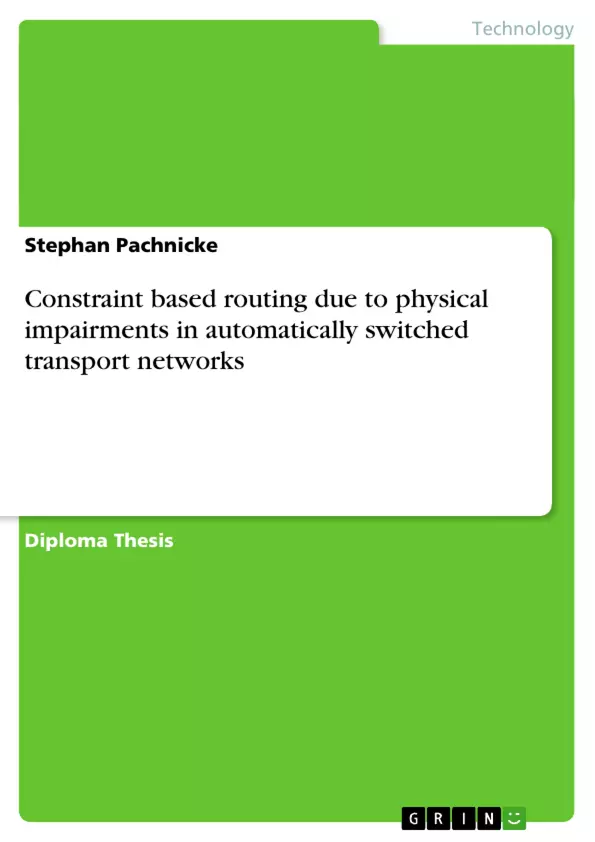Next generation optical communication systems will be characterized by increasing data rates, high signal powers and dense wavelength division multiplexing (DWDM). In future-optical networks channels will be routed through complex, meshed networks (ASTN, Automatically Switched Transport Networks, ITU-T Recommendation G.808 0/Y.1304). These networks will be able to setup transparent optical paths without converting the optical signals to electrical signals. In all-optical networks the physical impairments and degradation effects play an important role. There is a multitude of degradation effects like dispersion, noise, crosstalk, fiber nonlinearities, polarization dependent loss, etc. To enable a fast setup and the best choice of one of the available paths, the signal quality along the whole transmission distance has to be evaluated very fast.
Ideally, only a single figure of merit (FOM), e.g. the bit error rate (BER), will be computed, which incorporates all degradation effects. Therefore it is important to characterize the different physical impairments analytically. Signal distortions can be measured by an eye opening penalty (EOP) and degradation effects due to noise by the optical signal-to-noise ratio (OSNR). The goal is to find and calculate these impairments from the signal parameters (modulation format, data rate, duty cycle, channel spacing, etc.) as well as the route parameters (fiber lengths and parameters, EDFA powers, etc.). Due to the need of fast routing algorithms, time-consuming numerical methods or a complete system simulation are not practical. In addition, it is not possible to linearly accumulate the different degradation effects.
The focus of this work is to find analytical or heuristic formulas for each degradation effect. These approximation formulas are compared to the results obtained from a complete simulation of a reference system with the help of the simulation tool PHOTOSS.
Inhaltsverzeichnis (Table of Contents)
- ACKNOWLEDGEMENTS
- ERKLÄRUNG
- EINWILLIGUNG
- ABSTRACT
- SYMBOLS AND ABBREVIATIONS
- 1 INTRODUCTION
- 1.1 Introduction
- 1.2 Optical communications systems
- 1.3 Aims and objectives
- 1.4 Structure of this thesis
- 2 THEORY
- 2.1 Chapter overview
- 2.2 Maxwell's equations
- 2.3 Reflection and refraction
- 2.4 Dispersion and loss
- 2.5 Effective length and area
- 2.6 Nonlinear Schrödinger equation (NSE)
- 3 COMPONENTS
- 3.1 Chapter overview
- 3.2 Modulation format
- 3.3 Filter
- 3.4 Assessment of the signal quality
- 3.4.1 Eye opening penalty
- 3.4.2 Q-factor
- 4 LINEAR DEGRADATION EFFECTS
- 4.1 Chapter overview
- 4.2 Inter-channel crosstalk
- 4.2.1 Continuous-wave (CW) case
- 4.2.2 Non-return to zero (NRZ) case
- 4.2.3 Return to zero (RZ) case
- 4.3 Narrow-band spectral filtering
- 4.4 Optical demux filter optimization
- 4.5 Dispersion
- 4.5.1 Group velocity dispersion (GVD)
- 4.5.2 Third-order dispersion (TOD)
- 5 NONLINEAR DEGRADATION EFFECTS
- 5.1 Chapter overview
- 5.2 Four-wave mixing (FWM)
- 5.2.1 Approximation of the signal-to-crosstalk ratio
- 5.2.2 Simulations of the NRZ case
- 5.2.3 Simulations of the RZ case
- 5.3 Self-phase modulation (SPM)
- 5.4 Stimulated Raman Scattering (SRS)
- 5.4.1 Theoretical considerations
- 5.4.2 Continuous-wave (CW) case
- 5.4.3 Non-return to zero (NRZ) case
- 5.4.4 Effects of group-velocity dispersion (GVD)
- 5.4.5 Simulations of multi-span systems with GVD
- 6 EXAMPLES OF NETWORK PLANNING
- 6.1 Chapter overview
- 6.2 Variation of the channel input power
- 6.3 Variation of the number of WDM channels
- 6.4 Variation of the channel spacing
- 7 CONCLUSION AND OUTLOOK
- 8 REFERENCES
Zielsetzung und Themenschwerpunkte (Objectives and Key Themes)
This thesis investigates the impact of physical impairments on the performance of automatically switched transport networks. The focus is on constraint-based routing, which aims to optimize network performance while adhering to constraints imposed by physical limitations. The objectives are to understand the causes of impairments, analyze their effects on signal quality, and develop methods for mitigating these effects. The research focuses on the analysis of linear and nonlinear degradation effects, including crosstalk, dispersion, and non-linear phenomena such as four-wave mixing and stimulated Raman scattering.
- Constraint-based routing in automatically switched transport networks
- Analysis of physical impairments affecting signal quality
- Mitigation strategies for linear and nonlinear degradation effects
- Impact of different modulation formats and signal processing techniques
- Evaluation of network performance through simulation and modeling
Zusammenfassung der Kapitel (Chapter Summaries)
The thesis begins with an introduction to the field of optical communications systems, outlining the fundamental concepts and highlighting the importance of constraint-based routing in modern networks. Chapter 2 delves into the theoretical foundation of optical transmission, explaining Maxwell's equations, reflection and refraction, dispersion and loss, and the nonlinear Schrödinger equation.
Chapter 3 provides an overview of key components used in optical systems, including modulation formats, filters, and methods for assessing signal quality. Chapter 4 focuses on linear degradation effects, analyzing the impact of inter-channel crosstalk and dispersion on signal performance. The chapter explores different cases, including continuous-wave, non-return to zero, and return to zero modulation formats. Additionally, it investigates the optimization of optical demux filters for minimizing signal distortion.
Chapter 5 delves into nonlinear degradation effects, specifically four-wave mixing and stimulated Raman scattering. The chapter presents theoretical models and simulation results to understand the influence of these effects on signal quality. Finally, chapter 6 presents examples of network planning, exploring the impact of different parameters on network performance, such as channel input power, number of WDM channels, and channel spacing. The thesis aims to provide a comprehensive analysis of physical impairments in automatically switched transport networks, paving the way for improved network design and optimization.
Schlüsselwörter (Keywords)
The core focus of this thesis lies in the realm of constraint-based routing in automatically switched transport networks, with a particular emphasis on analyzing and mitigating the impact of physical impairments on signal quality. Key themes include optical communications, network optimization, linear and nonlinear degradation effects, inter-channel crosstalk, dispersion, four-wave mixing, stimulated Raman scattering, modulation formats, signal processing, and network performance evaluation.
- Quote paper
- Dr.-Ing. Stephan Pachnicke (Author), 2002, Constraint based routing due to physical impairments in automatically switched transport networks, Munich, GRIN Verlag, https://www.grin.com/document/50146



